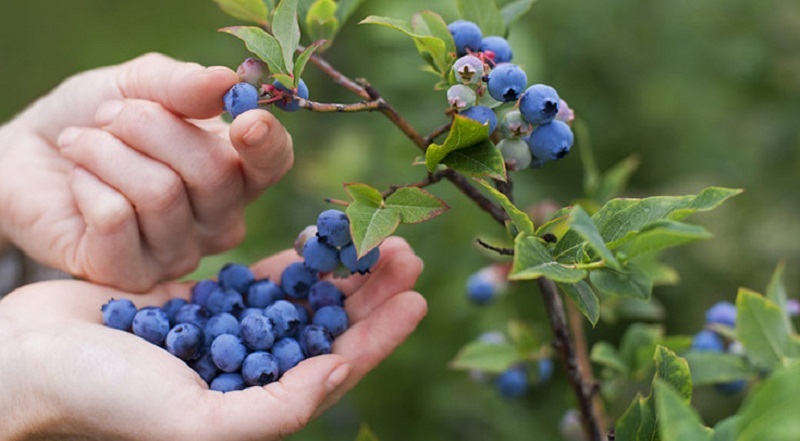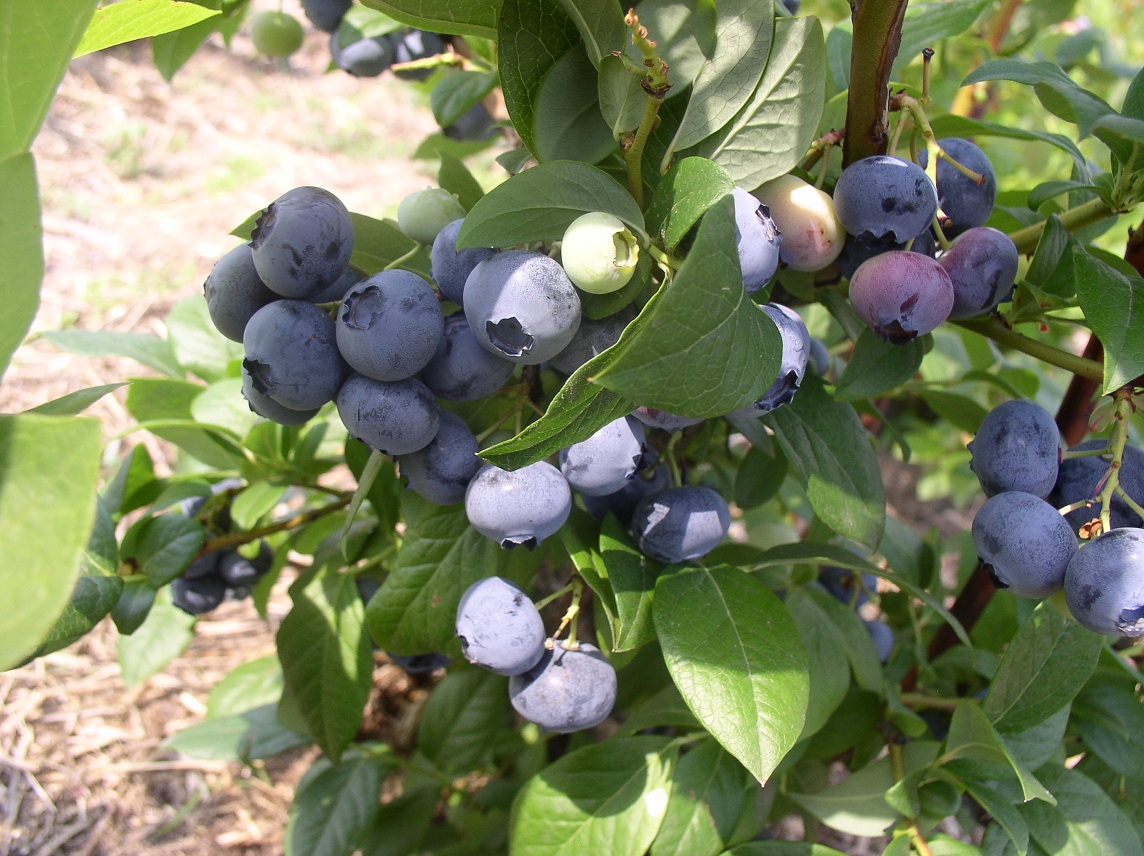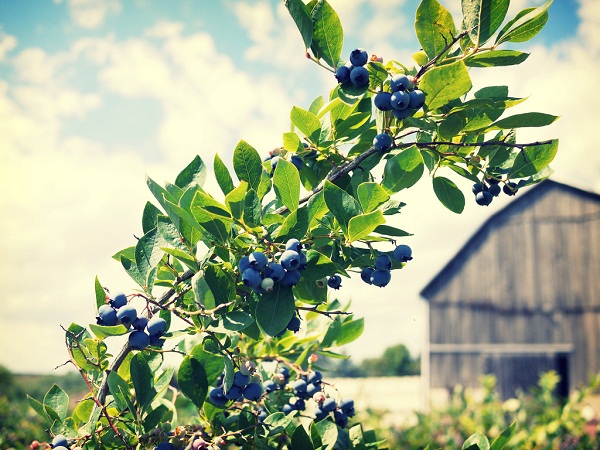 Blueberries are considered the most valuable berry crop in the world. This is due to the chemical composition of the berries, which is suitable for medicinal purposes. Meanwhile, the incredibly useful blueberries are still inaccessible to many Russians, although it can be grown on its site.
Blueberries are considered the most valuable berry crop in the world. This is due to the chemical composition of the berries, which is suitable for medicinal purposes. Meanwhile, the incredibly useful blueberries are still inaccessible to many Russians, although it can be grown on its site.
This was made possible, first of all, thanks to American breeders who “domesticated” wild forest berries, leaving all useful properties of black peas in new varieties and providing them with new modern functionality.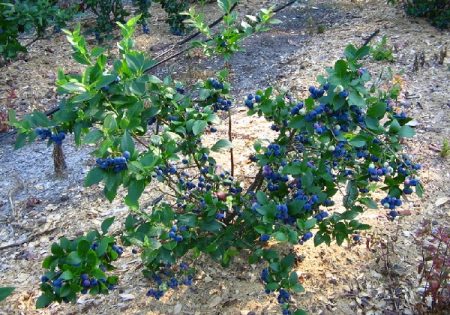
Garden blueberry is a tall, abundantly bearing plant. This culture is ideal for growing in the suburbs, as it has adopted special vitality from its wild relative. It is known that in the wild, the bush grows mainly in the northern latitudes, in particular in Iceland, North America, and Siberia. Her ability "in the blood" tolerates frosts up to -35 degrees, sudden changes in temperature, wind and waterlogging, as the favorite place of blueberries is a marshland.
The modern blueberry plant does not have such a long life cycle as found in the wild, but over the years of productivity, it is fully activated and gives simply excellent harvests. So from one bush you can collect 10-12 kilograms of gray berries, which are larger than natural ones in size and juiciness.
Domestic blueberries begin to bear fruit relatively early - already for 2-3 years of life, while its progenitor enters the productive period only for 15 years of life.
A significant disadvantage of garden blueberries is its short life. After six years of active fruiting, plant productivity drops sharply. This is manifested in the low quality of chopped berries and their small amount. Note: blueberries growing in nature are able to produce berries for 50 years. You can continue the genus of blueberries by regularly propagating it in various ways.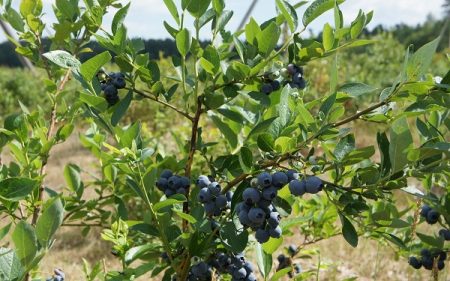
Content
- 1 The best harvested varieties for Moscow region
- 2 Growing Features
- 3 Site selection
- 4 Quality seedlings
- 5 Correct soil
- 6 Landing time
- 7 Landing technology
- 8 Transplanting blueberries to a new place
- 9 Blueberry Care
- 10 Preparing for the winter
- 11 Protection against diseases and pests
- 12 Harvesting
- 13 Propagation of blueberries in the suburbs
- 14 Green cuttings
- 15 Propagation by lignified cuttings
- 16 Conditions for rooting
- 17 Propagation by layering
The best harvested varieties for the Moscow region
Only adventurous people who grow big profits by selling such a rare and extremely useful product risk growing blueberries. To grow a berry solely for pleasure, naturally it is possible, however, this process is quite troublesome and painstaking. To facilitate the task, a correctly selected variety that meets all the requirements of the growing region will help. For the middle latitudes of Russia, early varieties of garden blueberries are optimally suited. They should also be frost-resistant, endure the troubles associated with an uneven climate, be immune to various diseases. Specialists also recommend giving preference to tall varieties. In all respects, varieties of American selection are suitable for the Central region:
| variety name | characteristic |
| Blucrop |
A variety of medium ripening. The bush is compact with a small number of shoots, reaches a height of 180-200 centimeters. Blue berries are large in size, great juiciness and astringent taste.Productivity above 9 kilograms per bush. Frost and drought tolerant variety.
|
| Patriot |
Begins to bear fruit in mid-July. Bushes are 150 centimeters high. Large fruits have a balanced delicate berry taste. The plant has a high shoot-forming ability, therefore, regular pruning and thinning of the bush is required. Branches are often overloaded with fruits. It has the property of self-pollination, but is also capable of cross-pollination. Productivity - 10 kilograms per plant. The variety is winter-hardy, has a high resistance to viral diseases, is not afraid of moisture and drought.
|
| Northland |
Harvest ripens in July. Bushes of medium height, grow just above a meter. They give a stable annual crop (up to 8 kilograms) of medium-sized, but very sweet berries of a dark blue color. With the correct formation of the crown, the bushes acquire a decorative character. Looks great along the hedge or fence.
|
| Northblue |
A short shrub (up to a meter high) is surrounded by dense dark green foliage and numerous shoots. The good taste of berries, which can be stored for a long time, is noted. Harvesting occurs in mid-August. The variety has high frost resistance, feels comfortable in the Moscow region and shows good yield indicators - 9-10 kilograms per plant.
|
| Blujej |
An early variety, giving powerful, sprawling, two-meter bushes, which during intensive fruiting are densely hung with berry clusters. The fruits are large, light blue in color with a whitish overflow. They do not crack, they are stored for a long time, they tolerate transportation well. The first berries ripen in late June. Productivity - up to 4 kilograms. Bluejack is immune to various diseases. It tolerates frosts up to -33 degrees. The variety is used mostly for commercial purposes.
|
| Chippewa |
The variety is not afraid of frost, disease. Ideal for cold and rainy areas. Bushes of medium height, compact, with straight shoots growing up. The fruits ripen early. They are large in size with a solid light blue skin and a tart aroma. Productivity from one bush is an average of 6 kilograms.
|
| Nelson |
The fruits have excellent taste, for which the variety has become very popular among consumers. Late variety - fruiting occurs in August. Plants take root well in any area and give an annual 6-kilogram offspring of large sweet berries. Bushes reach a height of 1.6 meters. They are spreading, powerful, densely leafy. They are rarely affected by diseases and pests.
|
| Duke |
Each bush of Duke variety blueberries gives up to 8 kilograms of selected fruits in July. Varietal plants are tall (up to 1.8 meters), sweeping, during the ripening period the branches, overloaded with fruits, go down to the ground. So that they do not break, they must be tied. Important features of the variety: it blooms late, is demanding on the level of humidity (there should not be much moisture), the fruits are ideal for fresh consumption.
|
| Bluegold |
Berries appear early, enter the stage of biological ripeness already in mid-July. The variety is unpretentious and even with minimal care and in bad weather conditions gives at least 5 kilograms of high-quality crop (maximum yield 7 kilograms). However, if the fruits are not removed on time, then they quickly dry. The bushes are branched, occupying a lot of space, up to 150 centimeters high. The berries are medium sized, sweet and juicy. Bluegold plants are not afraid of frost and a number of diseases. Great for growing in the northern parts of Russia. The disadvantage of the variety: overripe berries crumble easily.
|
| Bonus |
Large-fruited early blueberry variety. Tall bushes are very spreading, densely strewn with delicate white flowers during flowering, and when fruiting - clusters of fragrant berries the size of a coin. The berries are sweet, juicy.They do not crack or crumple during transportation; they are stored for a long time. The variety is high-yielding and gives up to 8 kilograms of selected goods annually.
|
| Herbert |
The fruits are quite large, have a rich taste and bright aroma. The height of the bushes reaches above two meters. They rarely get sick, easily tolerate even the most severe frosts. In the most fruitful year they give up to 10 kilograms of fruit.
|
| Elizabeth |
Perhaps the berries of this variety are the most delicious and fragrant of all. The fruits are large, with an unusually beautiful bluish-white overflow. Fully ripened, they are gathered in huge bunches and await collection, not falling and not cracking. Fruiting occurs in August and lasts unevenly. Berries are formed and ripen gradually until September. A plus of the variety is its easy and successful propagation by lignified cuttings. For healthy development, plants should not be planted on sandstones. They prefer loose and fertile soils. Under ideal conditions created, Elizabeth's yield reaches 6 kilograms.
note: GradeElizabeth named after an americanElizabeth White, "Progenitors" of garden blueberries.
|
Growing Features
In fact, blueberries are unpretentious plants. If you select the right soil for it and plant it correctly, then there will be no problems with leaving.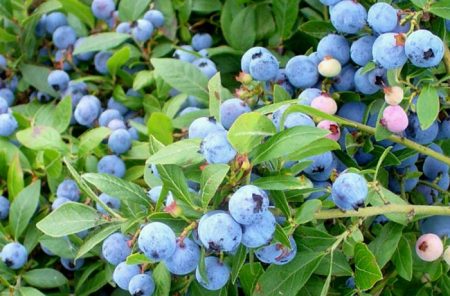
Site selection
Although in the forest, blueberries grow “in humid” places, this does not mean that you need to choose the wettest place in the garden. Absolutely not - the site should be well-lit, even, it is possible with a close occurrence of groundwater. The abundance of sunlight will contribute to the formation of larger, juicy and sweet berries. In the shade, a small and modest crop is obtained, and unpleasant acid appears in the taste of the fruit.
The place also should not go through, because due to the cold wind, the bark on thin branches is quickly damaged and infection can get into the plant. There should not be tall trees and bushes near the blueberry bushes - this can cause competition for soil nutrition, in which the blueberry will quickly lose due to surface roots.
Quality seedlings
Young cuttings are suitable for planting at one to two years of age. The stem and leaves must be healthy, have a dark green color, with no signs of rot and fungal damage. Healthy bark is smooth, glossy.
It is worth acquiring blueberry seedlings only in nurseries that sell plants with a closed root system. This is a prerequisite - seedlings must be in the pot in the correct soil substrate.
Correct soil
The ideal soil is peat or loamy, with good aeration and water permeability, since stagnation of water will immediately cause the death of roots located near the surface of the soil. Seedlings should grow on a layer of drainage (sawdust, spruce branches, sand).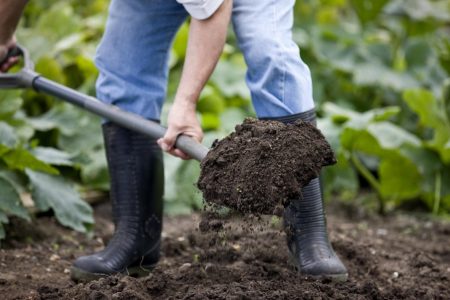
A prerequisite for the successful growth of culture is acidic soil. The pH should be between 3.5-5.5 units. If the site does not meet the requirements, it must be acidified with sulfur or citric acid.
When preparing the soil, one part of sand and three parts of peat are added to it. From fertilizers make complex minerals that contain an equal amount of nitrogen, phosphorus and potassium. Organics aren’t worth introducing - blueberries are not very honored.
Landing time
You can plant purchased seedlings both in spring and in autumn. However, it is preferable to still do this in the early spring, before the onset of sap flow and awakening of the eyes. During the summer warm period, blueberries take root well, which can not be said about spring planting - often the plants do not have time to take root. There is also a risk of freezing of immature shoots.
Landing technology
Blueberry seedlings are planted in deep holes (up to 50 centimeters). The dimensions of the pit are 50 * 50 centimeters. The hole is supplied with a prepared soil mixture, given that it should not contain ash - the plant does not like this. Further: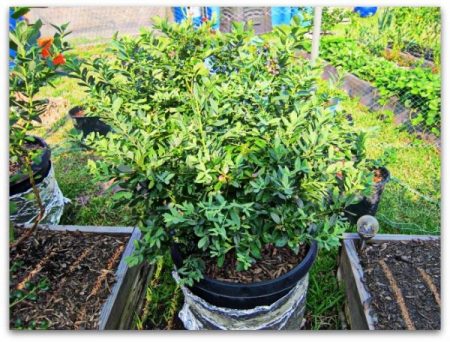
- 2/3 of the pit should consist of loose and fertile substrate of peat, sand, sawdust or needles. It also includes turf land. It is important that this soil composition is acidic.
- The soil is acidified with table vinegar or citric acid. You can also buy a special oxidizing agent in the store. However, one should not be too diligent with acidity - at a pH level above 5 points, the probability of plant disease with chlorosis is high.
- Do not forget about mineral fertilizers. They should contain a large dose of phosphorus and potassium. Nitrogen-containing drugs are selected with a high concentration of sulfur. Organics do not contribute.
- Plantations of blueberries are usually arranged in rows, leaving between 1 and 1.5 meters between the bushes.
- Before planting, the seedlings are well shed with water so that the soil in which they are located is wet and the roots can be easily untangled. The root system of blueberries is very fragile - the roots are thin and long.
- Having pulled out a seedling from a container, the earthen lump is broken, and the roots are carefully untangled. If this is not done, they will lose the ability to grow.
- The bush is immersed in a hole, carefully spread the roots to the sides and fall asleep with soil mixture. The root neck, when properly planted, should be deepened by three centimeters. A small depression should remain under the sapling in order to lay out a layer of mulch there. But first, blueberries are abundantly watered and only then are bark, straw, and needles laid. This will help retain water in the soil longer.
In autumn, landing is carried out according to the same principles as in spring. All weak shoots are cut off from young animals, and healthy ones are shortened by ½ part.
Transplanting blueberries to a new place
It is preferable to transplant shrubs at the age of two when they reach a half-meter height. Before digging up, all formed shoots and bud buds are removed. Plants are planted this time a little deeper than they had grown before, but no more than 3-5 centimeters. It is important that all roots are underground.
The soil does not need to be fertilized often, it is enough to fill the soil once a full mineral fertilizer in early spring during the growth of greenery and shoots.
Blueberry Care
So, the most important thing has already been done: healthy seedlings were bought and a competent planting was made. Next, you need to provide regular care for planting blueberries and wait for the first harvest.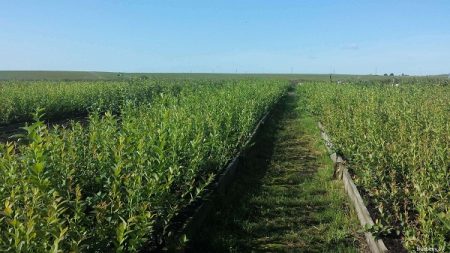
The soil around the shrub should always remain loose and light, slightly moist. True, zealous loosening is not necessary, otherwise you can dry the earth. You also need to remember that the root system of a blueberry bush is superficial, which means there is a risk of hitting the roots with a hoe. Sufficiently shallow (up to 8 centimeters deep) loosening. It is better that the area under the bush is mulled. Mulch has a number of properties necessary for the growth of blueberries:
- it retains moisture;
- prevents the weed from growing;
- protects roots from overheating;
- overripe, it nourishes the earth with vitamins and minerals.
Depending on the variety, blueberries may suffer from proximity to weeds or garden plantings, so this should also be taken into account when caring for plants.
Watering
Blueberries are very fond of moisture, but hate strong moisture. Stagnant water is disastrous for her. The first time after planting, young bushes are watered twice a day, spending a bucket of water for each plant. As soon as the seedlings get stronger and grow, watering is reduced.In the suburbs, where the climate is temperate, you can water once every 4 days. Moreover, this should be done even if it has recently rained.
Once a month, an oxidizing agent is added to irrigation water if the acidity of the soil is weak.
The frequency of watering increases during flowering plantings. This period is important for the future harvest. Untimely irrigation of bushes will lead to its reduction, and the resulting berries will not have juiciness and sweetness.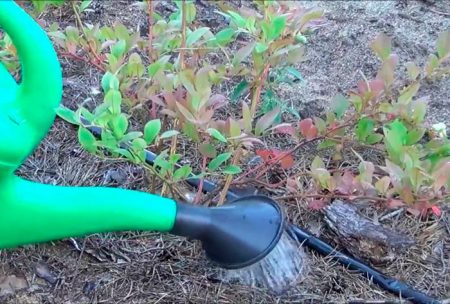
Top dressing
In the first year of life, blueberries do not need additional nutrition - they have enough of what the earth is rich in at the moment. By the second year, the smell of nutrients is depleted, it is then that fertilizers begin to be regularly applied. For full development and good productivity, plants need vitamins and minerals that are contained in complex preparations.
Nitrogen is necessary for the growth of shoots and the formation of fruits. Nitrogen-containing compounds process plantings three times per season. Arrange it before fruiting (in early spring, in May and in mid-June).
Phosphorus top dressing improves blueberry viability and enhances productive functions. Shrubs feed phosphorites in mid-April and June.
Potassium increases the protective functions of plants.
A good dose of potassium preparations provides a good wintering - the roots will not freeze, and the plant will not get sick. Fertilize blueberries with potassium according to the same principle as phosphorus.
In the Moscow region, blueberries need additional top dressing in the spring, namely during kidney swelling and another month later. They mainly use ready-made products containing all the ingredients necessary for nutrition, as well as soil acidifiers (Florovit, Target). For young plants, the doses of minerals are small. With age, the concentrate increases.
You should not often feed the plants and observe the state of the appearance of the stems and leaves. If they changed color or structure, then most likely the blueberry lacks one substance or another:
- leaves turn yellow - not enough nitrogen;
- leaves rise up and acquire a reddish tint - not enough phosphorus;
- the ends of the leaves turn black - you need to add potassium;
- young tops turn blue - the plant needs a bore.
Blueberry fruits develop on last year’s growth. That is why pruning blueberry bushes is necessary only in early spring, before the buds open. You should not deal with this fall, as there is a possibility of cutting high-quality, good branches with fruit buds. In this case, the harvest for the next year will be gone.
Pruning
Like any shrub, without formation, blueberries grow rapidly and turn into lignified impassable thickets. If the plants are not cut annually, then they will often get sick and give a weak offspring.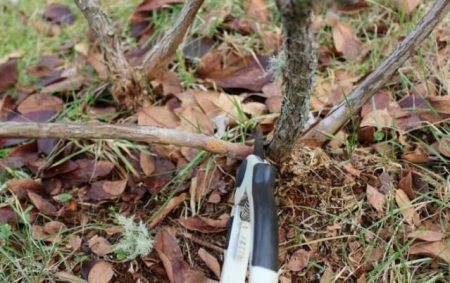
The formation of the crown and skeleton of the bush begin in the third or fourth year of his life. For this, all small small growths formed in the lower part of the bush are removed from the plant. Sick and broken branches growing in the wrong direction, as well as asexual shoots are also removed. The center of the bush should not be very thickened - this contributes to poor ventilation, which inevitably leads to the appearance of diseases. Leave on the bush only strong and strong stems growing up to the sides.
Next, annually it is necessary to maintain the plant in a “clean” state and conduct regular forming pruning, the purpose of which is to correctly distribute the forces of fruit-forming shoots.All shoots that create density, as well as lying on the ground, ruthlessly break out. 5-6 year old large faded branches are also removed.
To stimulate the growth of young animals and increase yields, shrubs from 8 years old are subjected to anti-aging pruning. Blueberries are freed from old and unnecessary branches, weak and sick shoots.
Preparing for the winter
Wild blueberries endure frosts - this is in her genes. Growing even in the northern regions, it is not afraid of even severe frosts. The home-grown berry adopted vitality from its parent, however, in especially cold and snowless winters, young branches of shrubs can still freeze. This can happen more due to the unbalanced composition of fertilizers that the plant was fed in the summer. An excess of nitrogen in the soil leads to the unripe aging of young animals. Annual stems have a dense and hollow structure. Because of this, they freeze in the winter. To prevent this from happening, nitrogen supplementation is carried out only in spring and early summer.
So that the soil, and therefore the roots, do not freeze before wintering, it must be supplied with a large amount of moisture. The soil should be moistened to 35 centimeters deep. In autumn, a layer of mulch from needles is replaced by a new one, they cover it with a section under the bushes. If the blueberry is still very young, then for the winter you can cover the shrub with completely breathable material. Adult bushes no longer need such protection.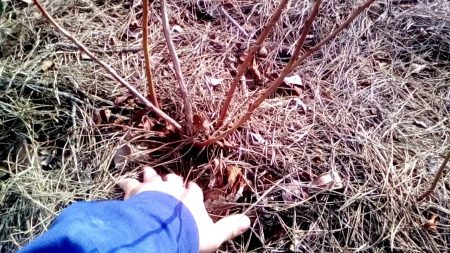
Protection against diseases and pests
Blueberries have a strong immunity to many serious diseases, but can not cope with such a dangerous disease as stem cancer. The first symptoms of the disease appear unexpectedly - the leaves are covered with red spots that spread lightning fast in all parts of the plant. Unfortunately, even strong fungicides cannot defeat cancer.
Disease can only be fought with prevention. In spring, blueberries are sprayed with a 3% solution of Bordeaux liquid, and Fundazol bushes are irrigated 5-6 times (the first three times before flowering, the next after harvest).
Often, stem cancer can be confused with another insidious enemy of garden blueberries - phomopsis. This is a fungal disease that dries out young shoots. Affected stems must be cut to the root and burned to prevent the spread of fungus. You can avoid the appearance of the disease with the help of spring treatment with fungicides.
Numerous pests like to enjoy strawberries. The main damage to the crop bring birds. To protect the berries, the bushes are hung with a net.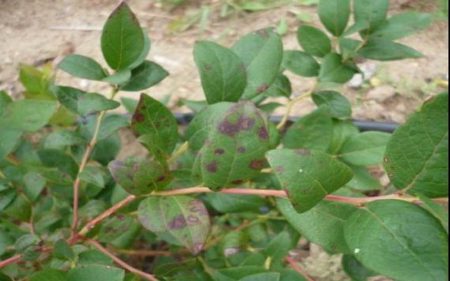
You can often find on the bushes of the May beetle, which feeds on both leaves and flowers, and the larvae located in the ground eat the roots. You can get rid of the beetle using insecticides, as well as using folk remedies - for example, setting sweet traps and sprinkling onion husks on the ground.
Harvesting
Fruiting in young blueberry bushes occurs in the third year after planting. The first fruits appear in mid-summer. Berries gather in huge gray clusters, strewn with sprawling bushes. Ripe, they can hang on the bush for a long time, not crumbling and not spoiling. Harvesting can be extended by periodically removing fully ripened berries in dry containers. The dense peel of berries does not allow them to burst and crease, which facilitates transportation. In the refrigerator, berries can be stored for almost a month, and in room conditions 7-10 days.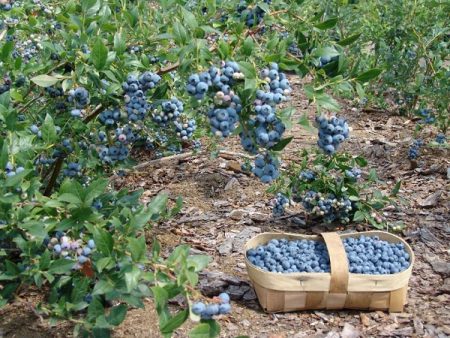
Propagation of blueberries in the suburbs
As already mentioned, unlike its wild cousin, garden blueberries have a very short life cycle. Starting to bear fruit only from the second or third year of life, by the age of six the plant degenerates - the berries become very small and their quality deteriorates. You can save the plantation by regularly propagating varietal plants. You can replenish the collection of delicious and healthy berries in various ways: vegetative (layering, cuttings) and seeds.
Vegetative (asexual) reproduction is the most effective and fastest way to increase the number of blueberry bushes. Most often, gardeners choose the method of cuttings, which allows you to quickly grow healthy and strong seedlings that will bring the first crop in a year.
Green cuttings
It is best to use young shoots grown this year as seedlings. With age, shoots become more desalinate, they contain less water balance, and metabolism is worse in them. Old branches take root longer and worse. Seedlings from green cuttings develop much faster, since the newly-born shoots are able to grow roots quickly enough.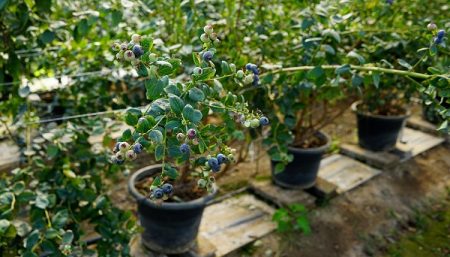
Planting material is harvested in late June (from the 20th day) - early July (until the 10th day). In the harvest of the shoots, special attention should be paid to the timing of the reproduction operation, since if the shoots are not mature enough, they will hurt and may dry out. This is due to the fact that their vegetative stage of development is not yet completed, and the plant does not fully receive and disbands nutrition along the stem and other parts. And if you are late with a fence of cuttings, then they will “outgrow” and their roots will grow for a very long time.
Young green twigs up to 18 centimeters long are cut together with leaflets and a heel (last year’s remaining wood at the cut end). The lower leaves are torn off, leaving only the apical foliage. Cuttings are rooted in greenhouse conditions in a moist mixture of peat, sand and humus. With proper care, which includes treatment with fungicides, watering, airing and maintaining the temperature regime, seedlings will overgrow with powerful roots after 40-45 days. Rooted seedlings are planted in a permanent place in early autumn. For the winter, plantings are reliably covered with warm breathable material.
Propagation by lignified cuttings
Many summer residents successfully plant blueberries with lignified cuttings. These are annual shoots that have a high ability to take root and give plants with the preservation of all varietal characters. Seedlings for seedlings can be harvested in advance, for example, at the beginning of winter, to plant them in the spring in the ground. Shoots can be cut in the middle of winter - the main condition is that at this time the plant is at a dormant stage. Cuttings are selected only strong and healthy, without signs of illness and mainly from the lower branches. They should have several sleeping intact kidneys (at least three). They are stored in the refrigerator or in the snow - as you like.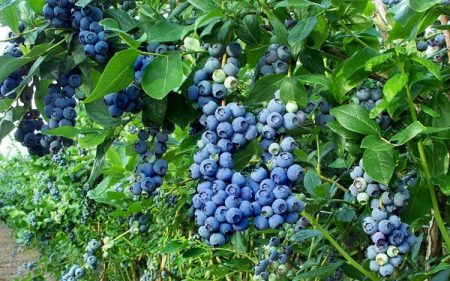
To stimulate root formation processes, it is recommended to treat the cuttings with a growth stimulant and at first keep them in a greenhouse in a moist peat-humus substrate. It is important to maintain high humidity not only in the soil, but also in the air and to prevent the cuttings from drying out. Seedlings take root within one and a half to two months. When the seedlings gain a fortress, they can be transferred to a permanent place of residence.
Conditions for rooting
Cuttings should be in the ground so that 1-2 kidneys remain on the surface.The temperature in the room should be at least 22 degrees. Humidity - 70-80%. Roots begin to form in a month. Only then will it be possible to remove the film from the greenhouse, and carry out frequent airing. After another 3-4 weeks, it will be possible to fertilize with ammonium sulfate. Finished cuttings are planted in a permanent place in the spring, as soon as the ground warms up thoroughly, and the air temperature does not fall below 0 degrees.
Propagation by layering
For leisurely summer residents, even if the blueberry plant has not yet reached the productive age, a new varietal bush can be obtained using layering. The fact is that reproduction occurs directly on the mother bush. The strongest and longest shoots are pressed to the ground and covered with nutrient soil to a depth of 6 centimeters. 2-3 kidneys should remain under the surface. This is usually done at the time of intensive plant growth - from April to September. The extreme part, being underground, will eventually become overgrown with the root system.
To root as quickly as possible, add the necessary fertilizing to the ground, water it and loosen it. As soon as this happens, the stalk can be disconnected from the common bush, as he himself will become independent. The method of propagation by layering is not so popular because of the length of the process, which takes about two to three years.
Garden blueberries are a very demanding and moody culture. Not all gardeners can grow it. This is due, first of all, with a little knowledge of the agricultural technology of this useful plant, which summer residents began to develop in their gardens relatively recently. Care and reproduction require a lot of time and expense, but getting valuable berries, such rare in our area, is worth it.

